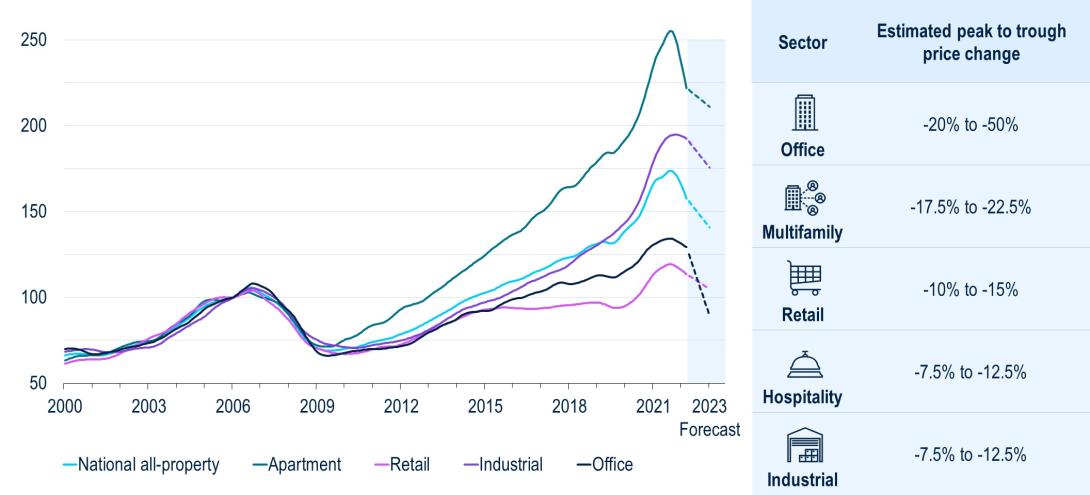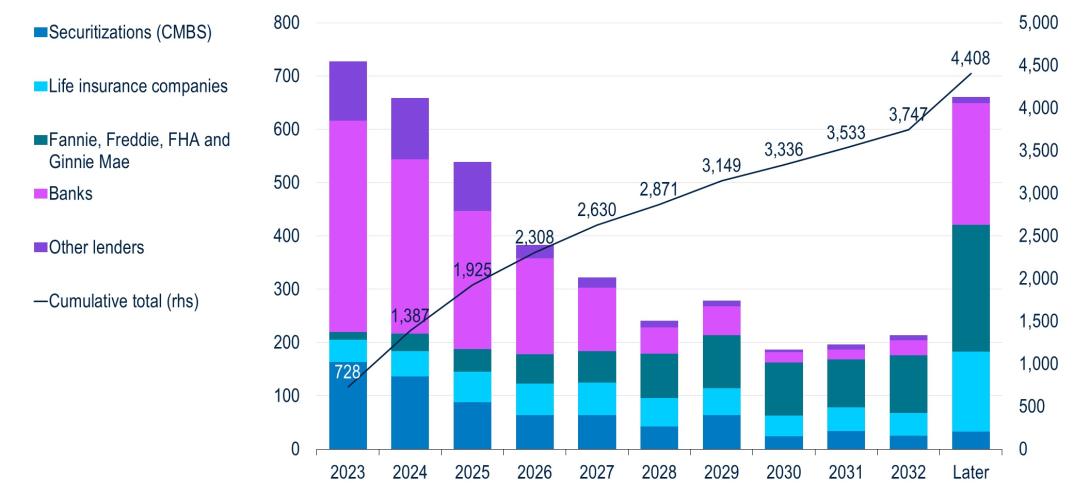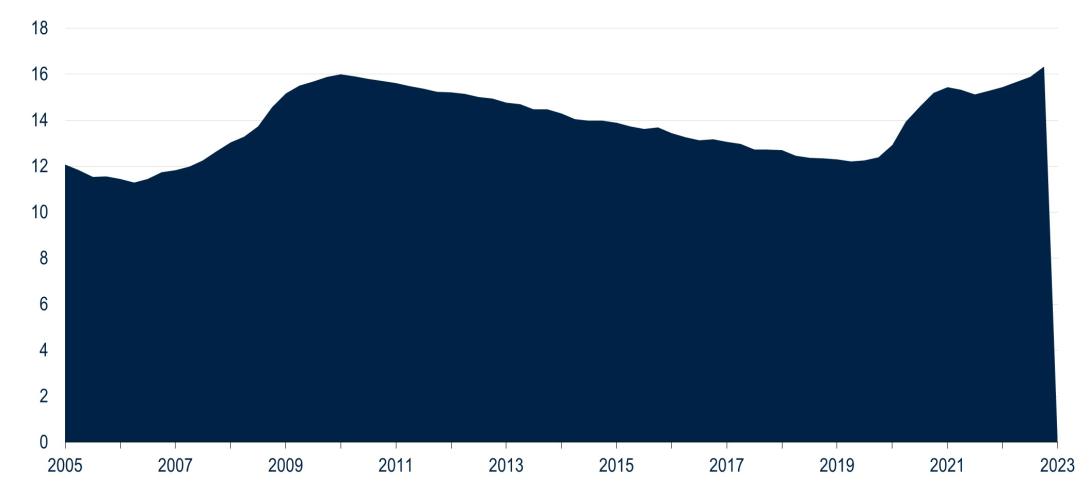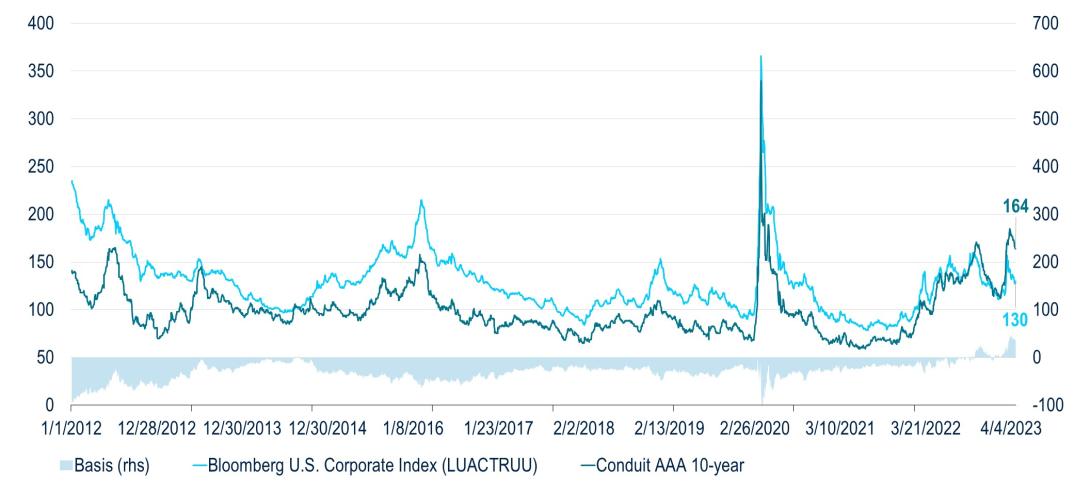Commercial Real Estate: Emerging Value Amidst the Storm

The commercial real estate (CRE) sector has recently faced a slew of negative headlines highlighting high-profile office loan defaults and a sector-wide decline in valuations. Rising rates, tighter lending conditions, weakening fundamentals, and a looming maturity wall create a difficult environment for the asset class. Turmoil within the regional bank sector further raises the specter of more pain ahead. While fully acknowledging the challenges facing the CRE market, we recognize value in certain, more defensive parts of the CMBS capital structure that have sold off too indiscriminately. Our investment strategy focuses on high-quality conduit securities that may benefit from credit stress in the underlying pool of CRE loans and takes a highly selective approach to subordinate credit within single asset single borrower (SASB) deals.
Given the breadth of concerns around the intersection of regional banks and commercial real estate, we provide a brief overview of current conditions within the CRE market, assess the implications of tighter lending conditions, and share our investment views in the current environment.
Rising Rates and a Looming Maturity Wall
Rising interest rates have significant implications on CRE valuations. Higher rates increase a property owner’s financing costs and, in turn, reduce the owner’s return on equity. As a result, purchase prices for new capital investments need to be adjusted lower to achieve target returns. While we’ve seen some re-pricing of CRE assets, we believe the current level of rates implies further strains on valuations going forward (Figure 1). In aggregate, we believe asset values need to decline further with significant dispersion across property sectors. With loan-to-value ratios generally underwritten in the 60% to 70% range, junior debt and equity owners will likely face the brunt of the value erosion.1 However, senior lenders could experience principal losses as well, particularly on loans collateralized by office assets.
Figure 1: Repricing of CRE sectors to continue in 2023 (RCA CPPI)

Source: RCA Capital Analytics and PGIM Fixed Income as of March 2023
Floating-rate debt poses additional (and more immediate) challenges for CRE loans. As debt service payments have rapidly risen above and beyond a property’s net operating income, borrowers could find themselves having to pay out of pocket to cover the difference. Moreover, floating-rate debt often comes with extension options which require the purchase of cost-prohibitive interest-rate caps (another potential out-of-pocket expense).
While fixed-rate borrowers may be better positioned, declining valuations and weakening fundamentals pose refinancing challenges for all types of debt. It is estimated that nearly $2 trillion of CRE debt is expected to mature over the next three years2 (Figure 2). Of the $700+ billion scheduled to mature this year, close to $400 billion is held by banks.
Figure 2: CRE Loan Maturities by Year ($ billions)

Source: Mortgage Bankers Association as of Q4 2022
The Office Malaise
Whereas the softening in fundamentals across most commercial real estate sectors has thus far been moderate, the office market has been especially hard hit due to the work-from-home transition. The office availability rate, currently at 16.3%,3 has steadily increased since the pandemic and now exceeds the Great Financial Crisis peak (Figure 3). Given the long nature of office leases, it will likely take several years for companies to right size their footprints and for availability rates to stabilize. Some high-cost markets, especially those with a greater local economic slowdown, have felt acute pain. San Francisco’s availability rate has risen from 7.1% pre-pandemic to an astonishing 32.7%.4 Effective rents, which account for concessions (e.g., free rent or budget for property improvements), have also declined as tenants now have more bargaining power. Although the challenges within the office sector are meaningful, it is important to note that the office sector is only one segment of the CRE market, comprising approximately 17% of the total CRE mortgages outstanding.5
Figure 3: Office Availability Rates Now Exceed GFC Peak (Percent)

Source: CoStar as of Q1 2023
Potential CRE Fallout from Banking Sector Stress
Recent bank failures have resulted in substantial deposit outflows across regional banks and highlighted liquidity risk within the banking system. Banks, currently responsible for approximately 50% ($2.7 trillion) of all CRE loans outstanding ($5.5 trillion) play a critical role in CRE funding6 (Figure 4). Over the past decade, banks have steadily increased their market share in CRE lending, with regional banks accounting for the lion’s share. Globally systemically important banks (GSIBs) and super regionals currently account for roughly 24% of all commercial real estate bank lending, while smaller regional and national banks account for the remaining 76%.7
Figure 4: Commercial Mortgage Debt Outstanding by Investor
 Source: U.S. Federal Reserve, as of Q4 2022
Source: U.S. Federal Reserve, as of Q4 2022
While the Federal Reserve’s Senior Loan Officer Opinion Survey indicates that banks began tightening lending standards for CRE loans in 2022, we expect the recent events in the financial sector to further impair lending availability and hasten property value declines. Regional banks are likely to limit new CRE lending activity as they focus on existing CRE exposures and seek to stabilize deposits. Furthermore, recent bank turmoil has increased the likelihood of additional regulation including: (a) higher liquidity requirements, (b) asset and liability hedging requirements, (c) higher capital requirements, and (d) more stringent underwriting criteria.
As stress within the CRE asset class builds and loan maturities are reached, loan defaults will likely rise within the banking sector. While modifications should be prevalent, they are not a cure-all for properties under considerable stress. Impairments and higher capital charges will likely precipitate distressed loan sales and could further accelerate property value declines.
CMBS Investment Opportunities
Amidst an uncertain economic backdrop, front-pay AAA conduit CMBS currently offers attractive risk-adjusted returns relative to other assets within the fixed income space. As seen in Figure 5, spreads have widened significantly in recent months and the basis between Conduit AAA CMBS and IG Corporates has now inverted (where CMBS is wider than IG)—something not seen in the past decade. While Conduit loans are generally weaker than those from balance sheet lenders, these securities are structurally insulated from credit and extension risk given their significant credit enhancement and payment priority within the deal waterfall. Due to rising rates and wider spreads, these securities generally trade at deep discount dollar prices and offer additional upside from defaults, which can result in unexpected principal payments at par.
Figure 5: Conduit AAA CMBS Now Trade Wide of IG Corporates (bps)

Source: JP Morgan, Bloomberg, PGIM Fixed Income as of 4/21/2023
Opportunities also exist further down the capital structure for investors with the resources and capabilities to perform rigorous bottom-up underwriting. We prefer SASB securities (securities backed by a single property or exposure to a single borrower) versus its conduit counterpart as exposure to a specific sector or specific asset can be targeted. As seen in Figure 6, spreads over the past year have widened significantly across all property types, with office and retail securities underperforming industrial, multifamily, and hotel securities.
Figure 6: BBB SASB Spreads Have Widened Significantly Across Sectors (bps)

Source: JP Morgan, PGIM Fixed Income, as of 4/21/2023
Spread widening across CRE has thus far been indiscriminate but has lacked dispersion within specific sectors as anemic trading volumes and a dysfunctional new issue market hinders price discovery. Spreads in the office sector have widened considerably as liquidity has largely dried up for most deals without regard to asset quality. While many office assets face functional obsolescence, the office sector, in the aggregate, will continue to exist and value is emerging within select properties and markets that are expected to survive. Correspondingly, while fundamentals within the industrial and multifamily sectors are generally sound, many loans originated at peak valuations over the past few years will likely struggle to refinance and mezzanine tranches could be at risk of principal losses in the event of further price erosion.
While the current environment presents many challenges for commercial real estate, investment opportunities are emerging across all parts of the capital structure for patient investors able to weather the price volatility in an asset class which is likely to see additional ratings downgrades, distressed workouts, and negative headlines.
Read More From PGIM Fixed Income
1 Source: Real Capital Analytics.
2 Source: Mortgage Bankers Association (MBA), as of Q4 2022. Excluding owner occupied CRE and construction loans.
3 Source: CoStar, as of Q1 2023.
4 Source: Savills, as of March 2023.
5 Source: Mortgage Bankers Association, as of Q4 2022.
6 Source: U.S. Federal Reserve, as of Q4, 2022.
7 Source: SNL, Bank of America Research, PGIM Fixed Income, as of Q4 2022.
The comments, opinions, and estimates contained herein are based on and/or derived from publicly available information from sources that PGIM Fixed Income believes to be reliable. We do not guarantee the accuracy of such sources or information. This outlook, which is for informational purposes only, sets forth our views as of this date. The underlying assumptions and our views are subject to change. Past performance is not a guarantee or a reliable indicator of future results.
Source(s) of data (unless otherwise noted): PGIM Fixed Income, as of 4/27/2023.
For Professional Investors only. Past performance is not a guarantee or a reliable indicator of future results and an investment could lose value. All investments involve risk, including the possible loss of capital.
PGIM Fixed Income operates primarily through PGIM, Inc., a registered investment adviser under the U.S. Investment Advisers Act of 1940, as amended, and a Prudential Financial, Inc. (“PFI”) company. Registration as a registered investment adviser does not imply a certain level or skill or training. PGIM Fixed Income is headquartered in Newark, New Jersey and also includes the following businesses globally: (i) the public fixed income unit within PGIM Limited, located in London; (ii) PGIM Netherlands B.V., located in Amsterdam; (iii) PGIM Japan Co., Ltd. (“PGIM Japan”), located in Tokyo; (iv) the public fixed income unit within PGIM (Hong Kong) Ltd. located in Hong Kong; and (v) the public fixed income unit within PGIM (Singapore) Pte. Ltd., located in Singapore (“PGIM Singapore”). PFI of the United States is not affiliated in any manner with Prudential plc, incorporated in the United Kingdom or with Prudential Assurance Company, a subsidiary of M&G plc, incorporated in the United Kingdom. Prudential, PGIM, their respective logos, and the Rock symbol are service marks of PFI and its related entities, registered in many jurisdictions worldwide.
These materials are for informational or educational purposes only. The information is not intended as investment advice and is not a recommendation about managing or investing assets. In providing these materials, PGIM is not acting as your fiduciary. PGIM Fixed Income as a general matter provides services to qualified institutions, financial intermediaries and institutional investors. Investors seeking information regarding their particular investment needs should contact their own financial professional.
These materials represent the views and opinions of the author(s) regarding the economic conditions, asset classes, securities, issuers or financial instruments referenced herein. Distribution of this information to any person other than the person to whom it was originally delivered and to such person’s advisers is unauthorized, and any reproduction of these materials, in whole or in part, or the divulgence of any of the contents hereof, without prior consent of PGIM Fixed Income is prohibited. Certain information contained herein has been obtained from sources that PGIM Fixed Income believes to be reliable as of the date presented; however, PGIM Fixed Income cannot guarantee the accuracy of such information, assure its completeness, or warrant such information will not be changed. The information contained herein is current as of the date of issuance (or such earlier date as referenced herein) and is subject to change without notice. PGIM Fixed Income has no obligation to update any or all of such information; nor do we make any express or implied warranties or representations as to the completeness or accuracy.
Any forecasts, estimates and certain information contained herein are based upon proprietary research and should not be interpreted as investment advice, as an offer or solicitation, nor as the purchase or sale of any financial instrument. Forecasts and estimates have certain inherent limitations, and unlike an actual performance record, do not reflect actual trading, liquidity constraints, fee. These materials are not intended as an offer or solicitation with respect to the purchase or sale of any security or other financial instrument or any investment management services and should not be used as the basis for any investment decision. PGIM Fixed Income and its affiliates may make investment decisions that are inconsistent with the recommendations or views expressed herein, including for proprietary accounts of PGIM Fixed Income or its affiliates.
Investing in the bond market is subject to risks, including market, interest rate, issuer, credit, inflation risk, and liquidity risk. The value of most bonds and bond strategies are impacted by changes in interest rates. Bonds and bond strategies with longer durations tend to be more sensitive and volatile than those with shorter durations; bond prices generally fall as interest rates rise, and low interest rate environments increase this risk. Reductions in bond counterparty capacity may contribute to decreased market liquidity and increased price volatility. Bond investments may be worth more or less than the original cost when redeemed. Mortgage- and asset-backed securities may be sensitive to changes in interest rates, subject to early repayment risk, and while generally supported by a government, government agency or private guarantor, there is no assurance that the guarantor will meet its obligations. High yield, lower-rated securities involve greater risk than higher-rated securities; portfolios that invest in them may be subject to greater levels of credit and liquidity risk than portfolios that do not. Investing in foreign-denominated and/or -domiciled securities may involve heightened risk due to currency fluctuations, and economic and political risks, which may be enhanced in emerging markets. Currency rates may fluctuate significantly over short periods of time and may reduce the returns of a portfolio. Commodities contain heightened risk, including market, political, regulatory and natural conditions, and may not be suitable for all investors. Diversification does not ensure against loss.
In the United Kingdom, information is issued by PGIM Limited with registered office: Grand Buildings, 1-3 Strand, Trafalgar Square, London, WC2N 5HR. PGIM Limited is authorised and regulated by the Financial Conduct Authority (“FCA”) of the United Kingdom (Firm Reference Number 193418). In the European Economic Area (“EEA”), information is issued by PGIM Netherlands B.V., an entity authorised by the Autoriteit Financiële Markten (“AFM”) in the Netherlands and operating on the basis of a European passport. In certain EEA countries, information is, where permitted, presented by PGIM Limited in reliance of provisions, exemptions or licenses available to PGIM Limited under temporary permission arrangements following the exit of the United Kingdom from the European Union. These materials are issued by PGIM Limited and/or PGIM Netherlands B.V. to persons who are professional clients as defined under the rules of the FCA and/or to persons who are professional clients as defined in the relevant local implementation of Directive 2014/65/EU (MiFID II). In certain countries in Asia-Pacific, information is presented by PGIM (Singapore) Pte. Ltd., a Singapore investment manager registered with and licensed by the Monetary Authority of Singapore. In Japan, information is presented by PGIM Japan Co. Ltd., registered investment adviser with the Japanese Financial Services Agency. In South Korea, information is presented by PGIM, Inc., which is licensed to provide discretionary investment management services directly to South Korean investors. In Hong Kong, information is provided by PGIM (Hong Kong) Limited, a regulated entity with the Securities & Futures Commission in Hong Kong to professional investors as defined in Section 1 of Part 1 of Schedule 1 (paragraph (a) to (i) of the Securities and Futures Ordinance (Cap.571). In Australia, this information is presented by PGIM (Australia) Pty Ltd (“PGIM Australia”) for the general information of its “wholesale” customers (as defined in the Corporations Act 2001). PGIM Australia is a representative of PGIM Limited, which is exempt from the requirement to hold an Australian Financial Services License under the Australian Corporations Act 2001 in respect of financial services. PGIM Limited is exempt by virtue of its regulation by the FCA (Reg: 193418) under the laws of the United Kingdom and the application of ASIC Class Order 03/1099. The laws of the United Kingdom differ from Australian laws. In Canada, pursuant to the international adviser registration exemption in National Instrument 31-103, PGIM, Inc. is informing you that: (1) PGIM, Inc. is not registered in Canada and is advising you in reliance upon an exemption from the adviser registration requirement under National Instrument 31-103; (2) PGIM, Inc.’s jurisdiction of residence is New Jersey, U.S.A.; (3) there may be difficulty enforcing legal rights against PGIM, Inc. because it is resident outside of Canada and all or substantially all of its assets may be situated outside of Canada; and (4) the name and address of the agent for service of process of PGIM, Inc. in the applicable Provinces of Canada are as follows: in Québec: Borden Ladner Gervais LLP, 1000 de La Gauchetière Street West, Suite 900 Montréal, QC H3B 5H4; in British Columbia: Borden Ladner Gervais LLP, 1200 Waterfront Centre, 200 Burrard Street, Vancouver, BC V7X 1T2; in Ontario: Borden Ladner Gervais LLP, 22 Adelaide Street West, Suite 3400, Toronto, ON M5H 4E3; in Nova Scotia: Cox & Palmer, Q.C., 1100 Purdy’s Wharf Tower One, 1959 Upper Water Street, P.O. Box 2380 - Stn Central RPO, Halifax, NS B3J 3E5; in Alberta: Borden Ladner Gervais LLP, 530 Third Avenue S.W., Calgary, AB T2P R3.
© 2023 PFI and its related entities.
2023-3587
Sign Up Now for Full Access to Articles and Podcasts!
Unlock full access to our vast content library by registering as an institutional investor .
Create an accountAlready have an account ? Sign in
